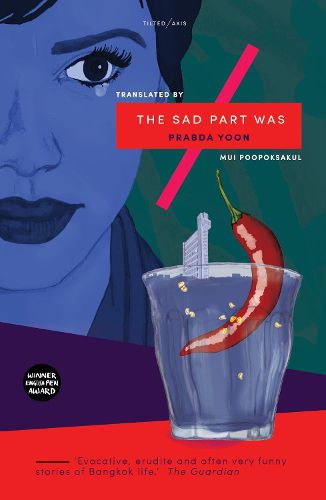This month we're reading fiction translated from: Danish, Italian, Japanese, Finnish, French and Thai.
On the Calculation of Volume: Book III
Solvej Balle, translated from Danish by Sophia Hersi Smith & Jennifer Russell
Tara Selter has lived the eighteenth of November 1,143 times when she notices a break in the pattern: a man has changed his shirt. The man is Henry Dale, and he remembers all the days that have come before. He knows that time has fallen out of joint. Now they are two of a kind – trapped in the eighteenth of November, but no longer alone.
Together they learn to share their present; their voices grow hoarse recounting their small battles against it and their bewilderment at the disintegrating world. Henry sees things differently to Tara: he does not think that time will put itself back together and he does not think that the future will come around. But he makes her realise that she is no longer the same person she was before this fault in time. And he makes her believe that there may be others to find within it.
Available from 18 November
My Brilliant Friend: The Four Volumes
Elena Ferrante, translated from Italian by Ann Goldstein
When Elena Ferrante set out to write the story of Elena and Lila, she conceived it as one single work of fiction, one expansive novel that would capture the reality and ambivalence of female friendship, motherhood, marriage, class and adolescence.
2025 marks 10 years since publication of the quartet was completed. To celebrate this anniversary, as well as honour and acknowledge the author's original conception, Europa are releasing the four novels in one volume.
Described by the New Yorker's James Wood as 'large, captivating, amiably peopled … a beautiful and delicate tale of confluence and reversal,' the Neapolitan Quartet tells a poignant, universal story about friendship and belonging.
Available from 18 November
The Ex-Boyfriend’s Favourite Recipe Funeral Committee
Saki Kawashiro, translated from Japanese by Yuka Maeno
Twenty-nine-year-old Momoko has been tragically dumped. She thought she and her boyfriend were in love. He even took her to a love hotel, where she thought he was going to propose. Instead, he dumps her.
Momoko does what many broken-hearted people do – she gets incredibly drunk. So drunk, that she passes out in an empty cafe. Eager to tell her story to anyone who will listen, she pours her heart out to a curious manager and the sole other customer in the cafe, a monk who trains at a temple nearby. When she starts to describe how she doted on her boyfriend, how he loved her cooking, the manager decides to indulge her, and allows her to slip into the kitchen, and cook up her ex’s favorite dish: a warm, delightful butter chicken curry. Soon, as Momoko finishes telling her story and as they all eat her dish, she realizes this combination of cooking and sharing has healed her heart in a way nothing else can.
The manager has an idea – what if they started doing this regularly, inviting in patrons to hear stories about breakups, heartbreaks, and tragic endings, and cook up dishes that meant something to the relationship? Like an unconventional therapy group, the 'Ex-Boyfriend’s Favourite Recipe Funeral Committee' is formed, with Momoko at the helm.
The Lucky Ride
Yasushi Kitagawa, translated from Japanese by Takami Nieda
In this charming story, the unluckiest man in Japan is given a chance to flip his fortunes when a mysterious driver appears, offering him the opportunity to seize a new path. Life’s setbacks can often feel overwhelming, but in The Lucky Ride, you’ll embark on a journey of self-growth that shows us that luck isn’t something you’re born with – it’s a result of the choices you make and the positive energy you bring into the world.
Set off on this heartwarming adventure and discover that luck isn’t a random gift – it’s something you build over time, a treasure that can be passed down through the generations. Yasushi Kitagawa’s uplifting and compassionate parable will inspire you to find joy in every moment, recognize the blessings in your life, and understand that by living each day with a good spirit, you’re crafting your own luck, one ride at a time.
The Woman Dies
Aoko Matsuda, translated from Japanese by Polly Barton
Piercing, inventive, and darkly humorous, the fifty-two stories in Aoko Matsuda's The Woman Dies explore the persistent and pervasive sexism faced by women in modern-day Japan.
The normalization of violence against women on screen and in the media is confronted in the story 'The Woman Dies', while others invest inanimate objects with their own perspectives, examine the aesthetics of technology, and use clever wordplay to riff off the absurdity of contemporary life.
Available from 2 December
Sympathy Tower Tokyo
Rie Qudan, translated from Japanese by Jesse Kirkwood
Welcome to the Japan of tomorrow. Here, the practice of a radical sympathy toward criminals has become the norm – and a grand skyscraper in the heart of Tokyo is planned to house wrongdoers in compassionate comfort. Acclaimed architect Sara Machina has been tasked with designing the city's new centrepiece, but is riven by doubt. As she casts her mind to the terrible crime she experienced as a young girl, she wonders if she might think against the grain of her time: could it be that criminals deserve the punishment and disdain of the past?
In search of solace, in need of creative inspiration, Sara turns to the knowing words of an AI chatbot …
Available from 25 November
The Wax Child
Olga Ravn, translated from Danish by Martin Aitken
It was a black night in the year 1620 when Christenze Krukow made the wax child, when she melted down beeswax and set it in the image of a small human. For days, she carried it tucked beneath her arm, shaping it with the warmth of her flesh, giving it life. She fashioned for it eyes and ears that cannot open, and yet – it watches and listens.
It looks on as Christenze is haunted by rumour, it hears what the people whisper. It sees how, in the candlelight, she gazes with love at her friends, and hears the things they say in the shadows. It knows pine forest, misty fjord and the crackle of the burning pyre. It observes the violence in men's eyes and the cruelty of their laws. In time, it begins to understand that once a suspicion of witchcraft has taken hold, it can prove impossible to shake …
Read our staff review here.
Lowest Common Denominator (The Helsinki Trilogy, Book 1)
Pirkko Saisio, translated from Finnish by Mia Spangenberg
Writing in the wake of her father's death, the narrator of Pirkko Saisio's autofictional novel transports us to the 1950s Finland of her youth, where she navigates life as an only child of communist parents. Convinced she will grow up to become a man, a young Pirkko keeps trying and failing to meet the expectations of the adults around her.
With wit and style, Saisio captures the heart-wrenching intensity of childhood feeling, merging fever dreams with sensory-laden memories as each formative experience – with the Big Bad Wolf, a bikini-clad circus announcer, and Jesus Christ himself – drives her further and further from her family and others. Struggling to understand her place in the world around her, it's in language that she discovers a refuge and a way to be seen at last.
Mona’s Eyes
Thomas Schlesser, translated from French by Hildegarde Serle
Fifty-two weeks. That's all the time Mona has left to learn about beauty before she loses her eyesight forever. Fifty-two works of art. Every Wednesday, Mona's grandfather picks her up after school and takes her to see a great work of art. Fifty-two chapters. Together, on their visit to Paris' museums, Mona and her grandfather will experience enchantment and sadness.
Above all, they will grow ever closer and learn to lean on each other. From Botticelli to Basquiat, Mona will discover not only the power of art, but also the meaning of generosity, doubt, melancholy, and loss. A profound, beautifully crafted novel about the fullness of life and an enthralling guide to the world's most renowned art, Mona's Eyes is a moving story about the bond between a young girl and her grandfather.
Available from 2 December
Beasts of the Sea
Iida Turpeinen, translated from Finnish by David Hackston
1741. The crew of Vitus Bering's ill-starred Great Northern Expedition are shipwrecked off a remote, uncharted island. With no hope of rescue, they give in to despair. Until they discover the flesh of a huge marine mammal that feeds in herds on the kelp in the bay.
1859. The Russian colony of Alaska is on the brink of collapse. Governor Hampus Furuhjelm takes solace in the quest for a unique artefact: a complete skeleton of what is now known as Steller's Sea Cow, rumoured to have disappeared a hundred years before.
Even extinct, the sea cow will continue to shape lives and destinies, from the woman charged with sketching its likeness from its bones, to the expert egg restorer who will refurbish those same bones a century later.
The Sad Part Was
Prabda Yoon, translated from Thai by Mui Poopoksakul
In these witty, postmodern stories, Yoon riffs on pop culture, experiments with punctuation, flirts with sci-fi and, in a metafictional twist, mocks his own position as omnipotent author.
Highly literary, his narratives explore the bewildering disjunct and oft-hilarious contradictions of a modernity that is at odds with many traditional Thai ideas on relationships, family, school and work.
Available from 1 December













